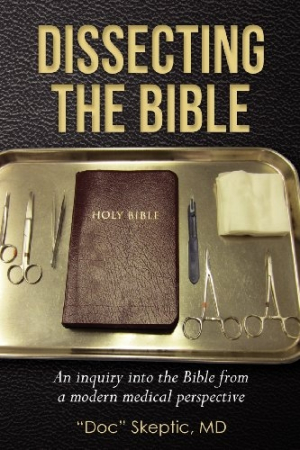
Dissecting the Bible
An Inquiry into the Bible from a Modern Medical Perspective
Miraculous events form the foundation of Christian faith and teaching, and both the Old and New Testaments of the Bible abound with miracles: the parting of the Red Sea, the ten plagues, and creation itself in the Old Testament, and the New Testament miracles of Jesus, through which the blind see, the lame walk, and the mute speak. Using a nom de plume to avoid offending his Christian friends and family, “Doc” Skeptic, a medical practitioner and a once-devout Christian, applies logic and science to the miracles recorded in the Bible and attempts to demonstrate that it is highly likely that none of them, including the death and resurrection of Jesus, actually happened as described.
The author is a practicing internist and was a member of the Plymouth Brethren from birth until, he writes, he “started thinking.” A passionate proponent of science, he applies the approach he would take in dissecting a human body to the “dissection” of the Bible’s medical miracles. In doing so, “Doc” Skeptic brings his sharp intellect and twenty-first-century medical knowledge to the task in the hope of providing readers with “the first seeds of doubt that may someday set some mind free.” After having abandoned his faith, he affirms that he has, as a result, experienced “enormous relief and satisfaction” at no longer having to maintain “a perpetual doublethink” to account for things in the Bible that do not make sense.
“Doc” Skeptic postulates that current science can readily explain the Bible’s medical miracles through its understanding of how the human body functions in health and in illness; for each biblical miracle, he offers multiple possible non-miraculous scientific explanations, thus providing readers with the tools and information needed for critical thinking. Both the reference material provided at the end of each chapter and the table of contents with its meticulous listing of the miracles covered in the text facilitate independent study.
The front cover is both attractive and appropriate, but the back matter is minimal, resulting in a back cover with too much blank space. While the type size and font make for easy reading, this is somewhat offset by the book’s lengthy paragraphs. The few errors in the text include occasional erratic spacing of words on the page and some incorrect word usage (“quatrain” should be “quartan”). More serious is that the author does not warn readers that the tenets of science, even when incorrect, can be held with as much fervor as any religious dogma.
In spite of the weighty material under consideration, the author maintains a conversational, and, at times, even humorous, tone as he asks and answers questions regarding scripture, including those relating to the virgin birth and divinity of Christ, and whether or not Jesus actually died on the cross and was resurrected. Unfortunately, the author’s tendency to suggest that Jesus might have deliberately deceived people by setting up false miracles may well be thought offensive, even by non-fundamentalist readers.
Overall, with its analytical “dissection” of the miracles of the Bible, this book is an excellent resource for those who desire to explore, and perhaps adopt, the author’s suggestion that religion be set aside in favor of a scientific approach to life.
Reviewed by
Kristine Morris
Disclosure: This article is not an endorsement, but a review. The publisher of this book provided free copies of the book and paid a small fee to have their book reviewed by a professional reviewer. Foreword Reviews and Clarion Reviews make no guarantee that the publisher will receive a positive review. Foreword Magazine, Inc. is disclosing this in accordance with the Federal Trade Commission’s 16 CFR, Part 255.
